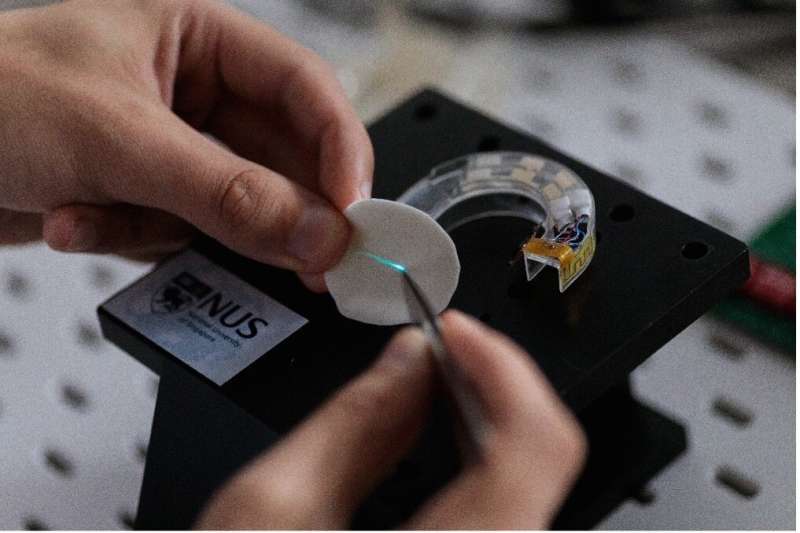A team of researchers from the National University of Singapore (Dr Luying Yi, left, Professor Xiaogang Liu, center, and Dr Bo Hou, right) have created a revolutionary mouthguard that uses bite force to operate electronic devices such as computers, smartphones, and even wheelchairs with high precision. . Credit: National University of Singapore.
Traditional interfaces for computers and other electronic devices allow humans to operate devices using only their fingers. However, recent technological advances have opened up valuable opportunities for developing alternative interfaces that use sound, eye blinks, facial or other body movements.
These alternative interfaces can change the lives of people with disabilities that prevent them from moving their hands freely. This includes people with partial or total paralysis, as well as patients with dystrophy, multiple sclerosis, cerebral palsy, and other neurological conditions that affect hand movements.
A team of researchers led by Xiaogang Liu at the National University of Singapore and Bin Zhou at Tsinghua University, has developed an innovative, interactive mouthguard that allows users to control and operate the devices by biting. This mouth guard was introduced in a paper published in nature electronicsbased on a series of mechanical luminescence Optical fiber sensors.
“Our work was inspired by dental diagnostics,” Bo Hu, first author of this paper, told TechXplore. “We thought of combining optical sensors And materials with a mechanical gloss to reveal the occlusal force of the teeth. Then we realized that it might be possible to control human-computer interactions through unique occlusal patterns.”
To create the interactive mouthguard, the research team used a series of mechanical fluorescence-operated distributed optical fibers (MP-DOF) sensors. These sensors consist of an array of flexible waveguides embedded with mechanical contact pads containing different colored phosphors that respond to pressure.

This revolutionary mouthguard – the first bite-controlled optoelectronic system – was invented by researchers from the National University of Singapore, which is affordable, lightweight, compact and requires less training time compared to current assistive technologies. Credit: National University of Singapore.
The researchers integrated two of these sensors into a mouthguard, a covering that protects humans from injury during exercise or prevents teeth grinding. Phosphors contained in the sensors are sensitive to mechanical stimuli, which eventually made it possible to create an interactive communication system controlled by a bite.
“The pressure and deformation of the elastic mouthguard in specific parts during occlusion is mapped with MP-DOF by measuring the ratio of the intensity of different color emissions in the fiber system, without the need for external light sources,” Liu explained. “Measurements of the relative density of complex occlusal bodies can be processed using machine learning algorithms to convert them into specific data inputs to obtain high accuracy. remote control and operating various electronic devices, including computers, smartphones, and wheelchairs.”
The researchers combined their mouthguard-based devices with machine learning algorithms trained to translate complex bite patterns into specific commands or data inputs. In initial evaluations, their system can successfully translate users’ bite patterns into data inputs with a remarkable accuracy of 98%.
Many assistive technologies, such as Voice recognition and eye tracking, both developed to provide alternative methods of control.”
An interactive interface based on mouthguards created by researchers could soon help improve the lives of people with limited skill, providing a viable alternative to keyboards or touch screens, thus allowing them to operate communication devices independently. Liu and his colleagues have already shown that the interactive mouthguard can be integrated with computers, smartphones and wheelchairs.
“In the future, we will try to explore opportunities to validate our devices in Clinical settingsLike in nursing homes or nursing homes, Liu added. “We are also developing a second generation of smart mouthguard to improve the user’s control speed and training time.”
Bo Hou et al., Interactive mouthguard based on optical fiber-optic sensors with mechanical flash to operate the bite-controlled device, nature electronics (2022). DOI: 10.1038 / s41928-022-00841-8
© 2022 Science X Network
the quote: Mouthguard based on fiber-optic sensor to operate devices with bite force (2022, October 24) Retrieved on October 24, 2022 from https://techxplore.com/news/2022-10-optical-fiber-sensor-based-mouthguard-devices .programming language
This document is subject to copyright. Notwithstanding any fair dealing for the purpose of private study or research, no part may be reproduced without written permission. The content is provided for informational purposes only.






